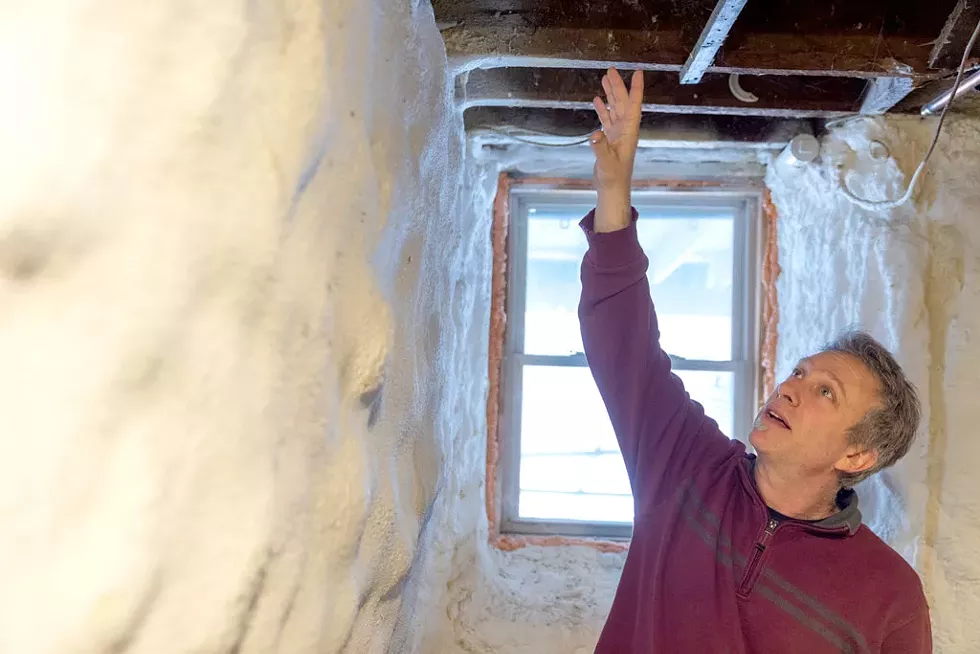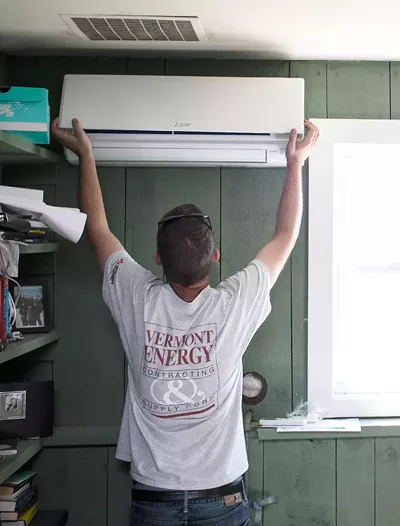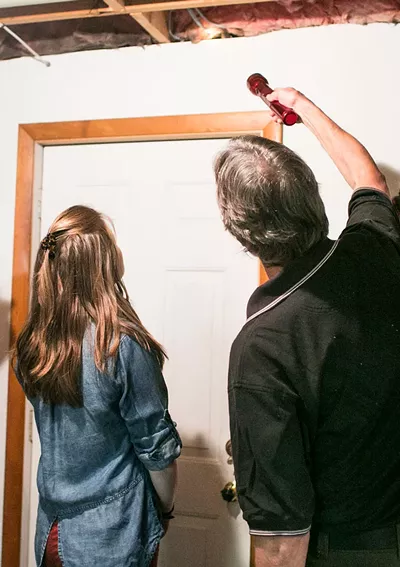click to enlarge
Feeling a cold draft in your house on zero-degree days? You’re not alone. Many Vermont residents have leaky spots in their homes where heat rushes out and cold air seeps in. The leaks aren’t always in the places you’d expect, either.
Many people assume the main culprits are window frames or a loose door jam, but that’s usually not the case according to Jake Marin, emerging technologies and services manager for Efficiency Vermont.
Marin’s a building expert. In addition to his work with the state’s energy-efficiency utility, he’s a former contractor, and he’s made some game-changing energy upgrades to buildings he’s owned himself.
Marin says often, people wrongly assume they need new windows to fix the problem. “Almost always,” he confides, “you should be looking at those spaces that you don’t really spend any time thinking about or going into: the attic and the basement.”
click to enlarge

Marin has some timely advice for those seeking to make their homes more comfortable, save money on heating bills, increase energy efficiency and cut down on greenhouse gas emissions.
Get Weatherized
The most important thing to do is weatherize your home. It doesn’t matter how energy-efficient your heating system is if the heat is escaping and you are uncomfortable, right?
Hot air rises inside a building from the lowest level — usually drawing cold air through the basement — shooting warm air out the top, through the attic. Think of them as your head, and your feet, says Marin. You basically need warm socks and a warm hat to keep out the chill.
In a basement, cold air often sneaks in through the band joists, where the floor sits on top of the building foundation. Maybe there’s an inadequate wad of fiberglass insulation tucked in the joists, he says. If so, they need a better seal with spray foam or sheet foam.
click to enlarge

In attics, fiberglass often lies on top of the ceiling without a tight seal, and the ceiling underneath is full of holes where wires or pipes from the house come through. Says Marin: “We don’t realize it, but it’s just Swiss cheese.”
A properly trained contractor will often toss the fiberglass and fill the holes with foam or caulking material. On top of that, the attic needs a “very consistent and thick layer of insulation” he says — most often cellulose, which is essentially shredded, recycled newspaper. It’s blown into the space like a cozy blanket, filling in all the nooks and crannies.
The payoff? “Weatherized buildings use less energy,” Marin says. “They’re more efficient buildings. So your bills are lower. Your carbon footprint’s smaller. And you’re more comfortable as well.”
Pump It Up
click to enlarge

Marin and his wife own a rental property, a Rose Street duplex; they used to live in one of the units. In 2013, he made a major upgrade: He did a comprehensive weatherization project and then installed a heat pump as the sole source of heat in the upstairs unit. He also added another pump for that unit’s hot water heater.
Heat pumps are a pivotal feature of an energy-efficient home, Marin explains. They don’t generate their own heat — they actually just move it around. “They’re extracting heat from the outside air and compressing it into a more usable, higher-quality heat, at a higher temperature, then delivering it into the indoor space,” he says. Heat pumps have been used for years in southern climates, but back in the 2010s, Efficiency Vermont worked with manufacturers like Mitsubishi, Fujitsu, and Daikin to adapt the technology to Vermont’s cold winter weather. “The heat pumps sold here in Vermont today can extract heat from temperatures as low as -15 degrees.”
Bonus: They can also reverse the process, moving heat from inside a home to the outside. Yep, they double as air conditioners for summer months.
Heat pumps run on electricity, and they can operate at better than 100 percent efficiency. Or, more accurately, they can provide two to four times more heat energy to your home than you put into them in the form of electricity. No other heating system can compare to this level of efficiency.
“They really are magic,” Marin quips, only half-joking.
click to enlarge

Because many of Vermont’s electric utilities acquire all or most of their power from renewable sources, replacing an oil-fired boiler with a heat pump can result in a significant reduction in greenhouse gasses and save you money.
For all of these reasons, Vermont has the highest heat pump adoption rate, per capita of any state. In recent years, Vermonters have installed about 10,000 of them annually.
Marin has been very satisfied with the heat pump he installed in his former home. “It’s been operating very inexpensively with no additional backup heating source in a 120-year-old building,” he says.
“Where things are starting to really come together is when you start talking about putting a heat pump into a building that has been weatherized,” Marin observes. “That’s where all of the benefits kind of add up.”
That’s true of his building. “One unit is completely being heated by a heat pump and is super tight, well-insulated, really inexpensive and comfortable,” he says. “That was a real success story.”
Get Started
click to enlarge

The journey toward your own success story starts with an energy assessment. A trained professional can assess how the air flows in your house, where it’s escaping and what can be done about it — and whether there are any health and safety issues, such as poor indoor air quality. The process will help you know where to start, and what to prioritize, Marin says, so you can “go after where you’re going to get the biggest bang for your buck.
Vermonters can seek an in-depth evaluation with one of Efficiency Vermont’s Efficiency Excellence Network members, who are Building Performance Institute-trained. They do a complete assessment, looking into tight spots and crevasses for hidden leaks.
You can find a list of qualified local contractors at efficiencyvermont.com/pro. Marin advises Vermonters to ask contractors about their services. Some will do a more cursory assessment at no charge. Others offer a more involved review for a fee.
It’s worth the investment, Marin says. “You’re getting a trained professional who’s going to look at this from a really comprehensive perspective.”
Learn About Incentives
Many energy-efficiency upgrades will save you money in the long run, but they come with upfront costs. Fortunately, a variety of incentives, rebates and financial assistance programs can help bring down the price. Here are just a few:
- Instant discounts for ductless heat pumps start at $350, plus a bonus for income-eligible Vermonters. Most electric utilities also work with Efficiency Vermont to offer additional rebates.
- Instant discounts for ducted heat pumps start at $1,000, plus a bonus for income-eligible Vermonters and additional utility offers. Incentives exist for heat pump water heaters, too.
- Buyers who choose a particularly high-performing ground source or geothermal heat pump can receive up to $2,100 per ton back from Efficiency Vermont, plus a federal tax credit of 26 percent of the total installed cost.
- Eligible homeowners can qualify for rebates of 50 percent off weatherization project costs (up to $3,000) done by an Efficiency Excellence Network contractor.
- Homeowners can apply for a Home Energy Loan from Efficiency Vermont for these projects. Efficiency Vermont works with lenders like VSECU and NeighborWorks of Western Vermont to base interest rates, which can be as low as zero percent, on a borrower’s income. In some cases, borrowers can pay off the loan with the money they save on their energy bills.
- Marin notes that low-income Vermonters may qualify for free weatherization services through state weatherization agencies. “And,” notes Marin, “we have partnerships with them so in some instances they’re also able to install a heat pump or swap old appliances with new ones. All for no cost.” For more information on free weatherization assistance, visit https://dcf.vermont.gov/oeo.
- Efficiency Vermont also offers a free home energy ‘’visit’’, which is now being done virtually, for anyone who looking for a light overview of where to save energy in their home.
Find more information about improving your property’s energy performance, and ways to help pay for it, at efficiencyvermont.com. It’s worth your time to investigate it, Marin advises, especially if you’re tired of drafty winter days.
“You’re improving your building, your home. And in the end, you’re improving your comfort,” he says.
That will make next winter much cozier.
This article was commissioned and paid for by Efficiency Vermont in support of the fight against climate change.
[ad_2]
Originally Appeared Here